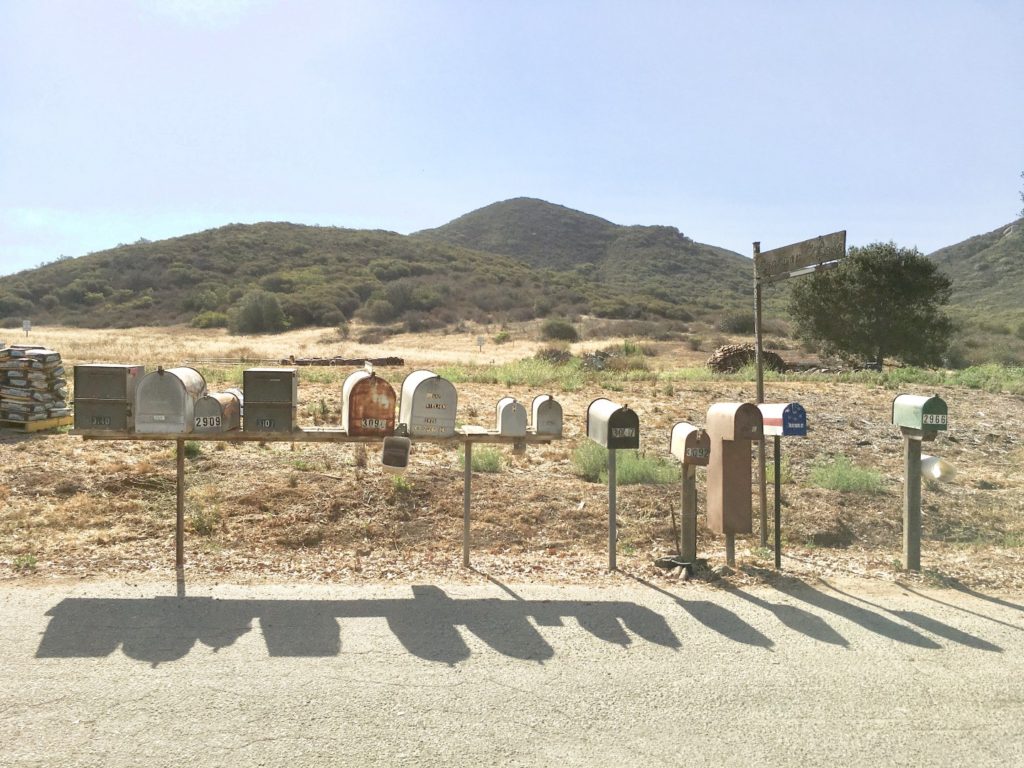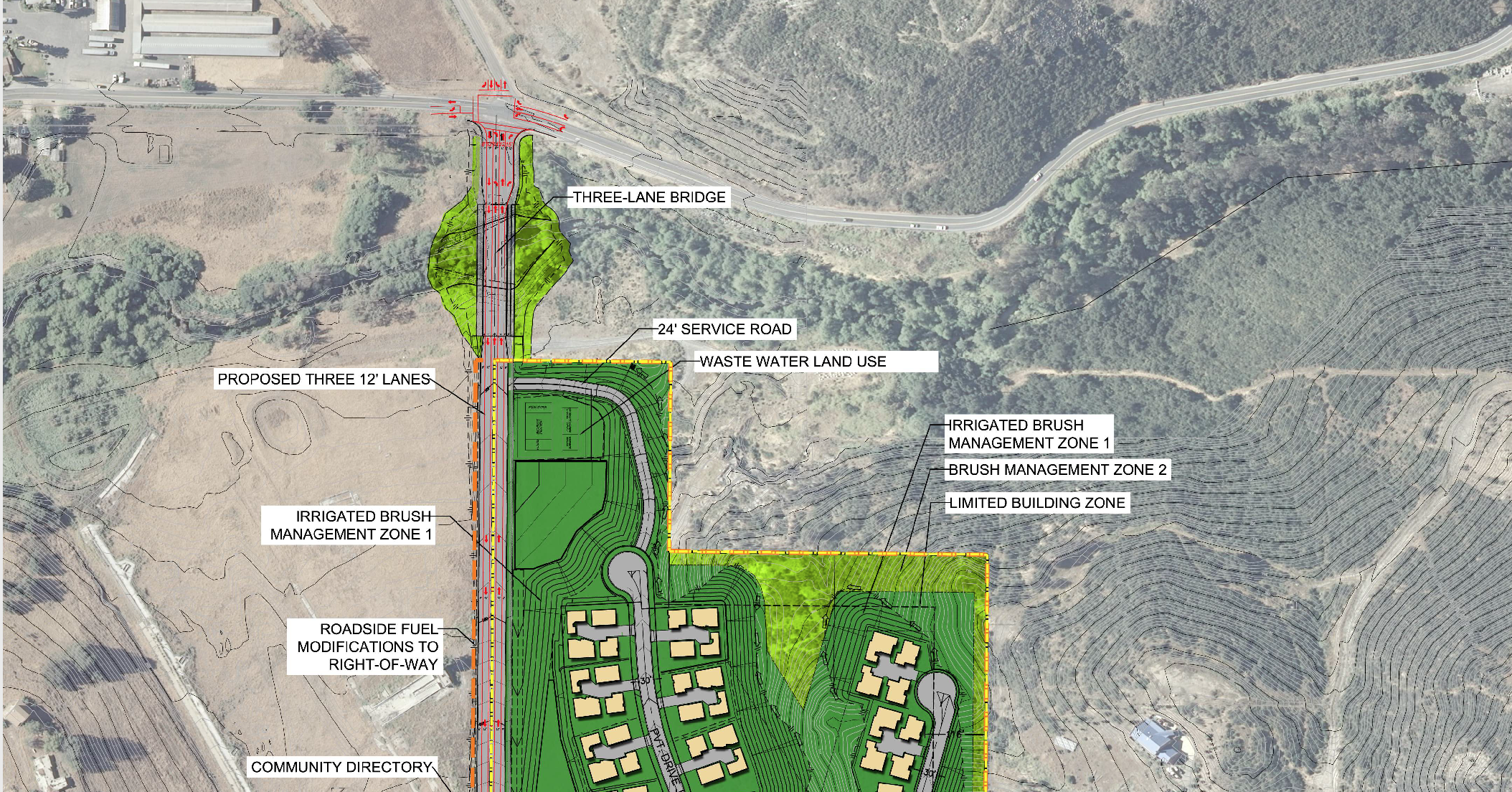Fire Code Exception for Dead-End Road
Country Club Drive is a single access, two-lane winding country road that crosses the Escondido Creek and eventually dead-ends 1.7 miles from the creek crossing. Today, sixty homes rely on Country Club Drive as their only exit from the area.
When a wildfire threatens developments accessible by one dead‐end road, potentially life threatening problems arise getting residents out and emergency first responders in. Even if access is not blocked by the fire itself, factors such as inadequate road widths, steep grades, presence of obstacles, etc., can interfere with safe/timely movement, causing entrapment of residents and the inability of responders to do their job.¹
Considering the deadly consequences of becoming trapped during a wildfire, the County of San Diego Consolidated Fire Code and the California Code of Regulations sets maximum lengths for dead-end roads. By putting forward a plan of 453 units with parcels of less than 1 acre, the Harmony Grove Village South (HGVS) development is subject to a dead-end road length of 800 ft max. A second means of access is required if this maximum dead-end road length is exceeded.
HGVS has a dead-end road of 4224ft, over 5 times the maximum allowed length and the developer has no plans for a secondary exit. For existing residents they are an alarming 11x the recommended distance.

Our Approach
Developer's Excuse
The developer of HGVS claims, “steep topography, wildland fuels, environmental issues, roadway distance to acceptable connections, and private ownership/easements” made a secondary exist infeasible.
The fire code isn’t something you throw out because logistical or financial constraints made it inconvenient.
The General Plan is the result of $18 million in taxpayer-funded studies and 13 years of work. The developer’s excuses for not meeting the bare minimum of fire safety are just proof that the General Plan correctly zoned the land in the first place. Environmentally the area is not meant for a large subdivision. But the developer wants the profit to be gained from forcing 453 homes into that space, without footing the bill for the corresponding additional infrastructure.
Our Story
Why the Developer's Mitigation is Insufficient
To receive an exception to the fire code the alternative measures must meet and/or exceed the secondary access requirement. The alternatives proposed by the developer are two-fold: (1) expand Country Club Drive to three lanes across the Escondido Creek and for the portion of the road in front of the proposed development, and (2) use fire-resistant building materials and landscape practices so trapped residents can shelter-in-place.

One Better Road Is Still One Road
Widening the existing two-lane road to three lanes is the crux of the developer’s argument. Since the intent of the relevant fire code is to ensure safe evacuation, the developer’s reasoning is that a three-lane road will allow for faster evacuation than a two-lane road.
What’s interesting about this proposal is, if simply making the road into 3 lanes was all that is necessary to mitigate the danger, why didn’t Cal Fire write the code that way? Why doesn’t the regulation read, “except for when the dead-end road is 3 or more lanes”?
They didn’t write the code that way because simply widening a section of the road does not address the limitations of only having a single way to enter or exit the community. A single exit that can become blocked by fire or vehicle collisions in a panicked evacuation.
Single‐Access Subdivisions Assessment Project
In 2016, Cal Fire and the State Board of Forestry and Fire Protection contracted fire experts to examine the current dead-end road standards and their effectiveness. After modeling evacuation times for single-access subdivisions in Southern California, researchers at the California Polytechnic State University, San Luis Obispo, addressed this very issue in their report to Cal Fire:
“Simply adding an additional lane to the primary single access road for evacuation does not appear to improve evacuation time. Adding a true second access that is independent of the first (meaning the two exits are neither close together nor access the same through road) offers a significant reduction in clearance time.”
Evacuation Times Slower Than Wildfire Modeling
Even if the single evacuation route does not become blocked in a wildfire, the HGVS project will add over 1500 vehicles to Country Club Dr. during an evacuation. The HGVS Evacuation Plan states it could take as long 1.25 to 2.25 hours to complete a community wide evacuation, and double that or longer if a Harmony Grove/Eden Valley-wide evacuation is declared.³ Meanwhile the county’s Wildfire Risk Analysis estimates the fire travel time from Escondido, in average Santa Ana wind conditions, would be 1-2.5 hours. Fire starting closer to the proposed development site could produce much shorter run times.⁴
Evacuation takes 1.25 hours and a fire will take less than an hour to reach the development.